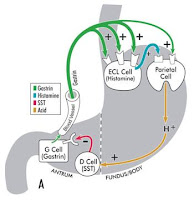Friday, 26 October 2012
အစာအိမ္နွင့္ အူ လမ္းေၾကာင္း တြင္ ေတြ႔ရေသာ ေဟာမုန္းမ်ား
အစာ အိမ္ႏွင့္ အူလမ္းေၾကာင္း မွာ ေဟာ္မုန္း ၂၀ ေက်ာ္၊ ၃၀ နီးပါး ထုတ္လုပ္ တယ္။ ဒီေဟာ္မုန္း ေတြဟာ Amino Acid ေတြနဲ႔ ဖြဲ႕စည္းထားတဲ့ Peptides ေတြျဖစ္တယ္။ Peptides ေခၚတဲ့ ေဟာ္မုန္းေတြကို အျခား Tissue ေတြမွာလည္း ေတြ႕တယ္။ အထူးသျဖင့္
ဦးေႏွာက္ထဲမွာ ေတြ႕ တယ္။ သူတို႔ဟာ နည္း ၂ မ်ိဳးနဲ႔ အာနိသင္သက္ ေရာက္တယ္။ နည္း တစ္မ်ိဳး ကေတာ့ ထုတ္လုပ္တဲ့ ကလာပ္ စည္းရဲ႕ အနီးအနားမွာ ရွိတဲ့ ကလာပ္ စည္းေတြ ေပၚမွာ အာနိသင္ သက္ေရာက္ တဲ့နည္း ျဖစ္တယ္။ ဒါကို Paracrine အာနိသင္လို႔ ေခၚတယ္။ ဒီလိုသက္ ေရာက္တဲ့အခါ သူတို႔ကို Peptides လို႔ပဲ ေခၚတယ္။ ေဟာ္မုန္း လို႔မေခၚဘူး။ ဒါေပမယ့္ ေနာက္တစ္နည္းအေနနဲ႔ ဒီ Peptide ေတြဟာ ေသြးထဲကို ေရာက္သြားၿပီး အျခားအဂၤါ ေတြေပၚမွာ သက္ ေရာက္ရင္ ေဟာ္မုန္းလို႔ေခၚ တယ္။ အစာအိမ္နဲ႔ အူလမ္းေၾကာင္း က ထုတ္လုပ္တဲ့ ေဟာ္မုန္းေတြကို ေလ့လာၾကည့္မယ္။ ဒီေဟာ္မုန္းေတြက ေတာ့-
■ Gastrin (ဂက္စထရင္)
■ Somatostatin (စိုမာတိုစတတင္)
■ Secretin (စီခရီတင္)
■ Cholecystokinin (CCK) (ကိုလီစစ္စတိုကိုင္နင္)
■ Fibroblast Growth Factor 19 (FGF 19) (ဖိုက္ဘ႐ိုဘလက္စ္ ဂ႐ို႕သ္ ဖက္တာ)
■ Incretins (အင္ခရီတင္)
■ Ghrelin (ဂရီလင္)
■ Neuropeptide Y (NPY) (ႏ်ဴ႐ိုပက္ပ္တိုက္ ဝိုင္)
■ Peptide YY 3-36 [PYY (3-36)]
■ Motilin
■ Substance P တို႔ ျဖစ္ၾကတယ္။
တကယ္ေတာ့ ေဟာ္မုန္းေတြကို သူတို႔ရဲ႕ ဓာတုေဗဒ ဖြဲ႕စည္းပံုခ်င္း ဆင္တူမႈ အလိုက္ အုပ္စုဖြဲ႕ ထားတာေတြ လည္းရွိတယ္။
၁။ Gastrin-Cholecystokinin ဒီအုပ္စုထဲမွာ ပါဝင္တဲ့ Hormone ေဟာ္မုန္း ေတြကေတာ့ Gastrin နဲ႔ Cholecystokinin ျဖစ္တယ္။
၂။ Secretin Family ပါဝင္တဲ့ ေဟာ္မုန္းေတြ ကေတာ့ Secretin, Glucagon, Vasoactive Intestinal Peptite (VIP) နဲ႔ Gastric Inhibitory Peptite (GIP) တို႔ျဖစ္တယ္။
၃။ Somatostatin Family
၄။ Motilin Family
၅။ Substance P တို႔ျဖစ္ၾကတယ္။ Grastin အစာအိမ္ဟာ စားလိုက္တဲ့ အစာ ကို လက္ခံ႐ံု သာမက အစာေျခဖ်က္ တဲ့ လုပ္ငန္းလည္းလုပ္တယ္။ အစာအိမ္ ရဲ႕ အေပၚပိုင္းမွာ Gastric Juice အစာအိမ္စစ္ ထုတ္ရည္ေပးတဲ့ Exocrine Cells ေတြရွိတယ္။ တစ္ခု က Chief Cells လို႔ေခၚတယ္။ Pepsinogen ဆိုတဲ့ အစာေျခရည္ ကို ထုတ္ေပးတယ္။ ေနာက္တစ္ခုက Parietal Cells လို႔ေခၚတယ္။
Hydrochloric Acid အရည္ကို ထုတ္ေပးတယ္။ ဒါ့အျပင္ Neuroendocrine Cell လို႔ေခၚတဲ့ Enterochromaffin Like (ECL) Cells ေတြ ရွိေသးတယ္။ သူတို႔က ေတာ့ Exocrine Cell မဟုတ္ဘူး။ Endocrine Cells ေတြျဖစ္တယ္။ အစာအိမ္ အေပၚပိုင္းဟာ အစာကို လက္ခံတဲ့အပိုင္းျဖစ္တယ္။ Pepsinogen နဲ႔ Acid ပါတဲ့ စစ္ထုတ္ ရည္ကိုထုတ္ေပးတယ္။ Pepsinogen က Acid နဲ႔ေတြ႕တဲ့အခါ Pepsin ျဖစ္လာၿပီး Protein အသားဓာတ္ကို ၿဖိဳခြဲတယ္။ အစာအိမ္ ေအာက္ပိုင္းကို Antrum လို႔ေခၚတယ္။ သူက အစာ ကို ႀကိတ္ေျခတဲ့ အပိုင္းျဖစ္တယ္။ သူ႔ မွာ ေဟာ္မုန္း ထုတ္ႏိုင္တဲ့ G-Cell နဲ႔ D-Cell ၂ မ်ိဳးရွိတယ္။ G-cell က Gastrin ကိုထုတ္ေပးတယ္။ Gastrin က ေသြးထဲကိုေရာက္သြားၿပီး Parietal Cells ကို Acid ထုတ္ေစ တယ္။
ေနာက္တစ္နည္း ကလည္း ECL Cell ေပၚက Gastrin Receptor ေပၚမွာေပါင္းၿပီး ECL ဆဲလ္ကေန Histamine ကိုထုတ္ေစ တယ္။ Histamine က Parietal Cell ကို အက္စစ္ ထုတ္ေပး ေစတယ္။ Gastrin Receptor ကို CCK2 Receptor (Cholecystokin) လို႔လည္းေခၚတယ္။ အစာအိမ္ထဲမွာ Acid မ်ားလာ ရင္ ျပန္ၿပီး ဟန္႔တား ရတယ္။ Acid ေတြက Antrum ထဲက D-cell ကို လံႈ႕ေဆာ္ၿပီး Somatostatin (SST) ကို ထုတ္ေစတယ္။ Somatostatin က G-cell ကို ပိတ္တယ္။ Gastrin အထြက္နည္းသြားတယ္။ Gastrin အထြက္နည္းရင္ Acid အထြက္ နည္းတယ္။ ဒါကို Negative Feedback လို႔ေခၚတယ္။ Gastrin ဟာ အစာအိမ္ရဲ႕ ေနာက္ဆံုးအပိုင္း Antrum ရဲ႕ ညႇစ္ အားကို ေကာင္းေစတယ္။ Pancreas ကိုလည္း စစ္ထုတ္ရည္ေတြ ထြက္ေအာင္ လံႈ႕ေဆာ္တယ္။ သည္း ေျခအိတ္ Gall Bladder ကိုလည္း ညႇစ္ေစတယ္။ Gastrin ၃ မ်ိဳးရွိတယ္။
၁။ Big Gastrin - Gastrin - 34
၂။ Little Gastrin - Gastrin - 17
၃။ Minigastrin - Gastrin - ၁၄ တို႔ျဖစ္ၾကတယ္။ Minigastrin က Active အျဖစ္ဆံုး၊ အစြမ္းထက္ဆံုး ျဖစ္တယ္။
ဒီေဟာ္မုန္း ေတြရဲ႕ ေနာက္ဆံုးအပိုင္း Amino Acid ၅ ခုကို ဓာတ္ခြဲခန္း ေတြမွာ တည္ေဆာက္ ယူတယ္။ ဒါကို Pentagastrin လို႔ေခၚတယ္။ နံပါတ္ ေတြက Amini Acid အေရအတြက္ ကို ေျပာတာျဖစ္တယ္။ Gastrin ဟာ အစာအိမ္ တင္း လာရင္ ထြက္တယ္။ Vagus Nerve ကို လံႈ႕ေဆာ္ရင္လည္း ထြက္တယ္။ Protein ေတြ ၿပိဳကြဲတဲ့အခါရတဲ့ Peptide တို႔၊ Amino Acid တို႔က လည္း Gastrin ကို ထြက္ေစ တယ္။ ေသြးထဲမွာ Calcium ဓာတ္မ်ားရင္ လည္း Gastrin အထြက္မ်ားတယ္။ Acid အထြက္မ်ားရင္ Gastrin အထြက္ကို နည္းေစတယ္။
Somatostatiin (SST), (GIP), (VIP), (Glucaton), (Calcitonin) ေဟာ္မုန္း ေတြကေတာ့ အထြက္နည္း ေစတယ္။ Pancreas တို႔ Duodenum တို႔မွာရွိတဲ့ G-cell ေတြက Gastrinoma လို႔ေခၚတဲ့ အလံုး Tumor ျဖစ္တယ္။ Gastrinoma လို႔ေခၚ တယ္။ Gastrin ေတြကို အမ်ားႀကီး ထုတ္တယ္။ ေသြးထဲမွာ Gastrin ေတြ မ်ားလာတယ္။ ေသြးထဲမွာ Gastrin မ်ားရင္ အစာအိမ္ထဲမွာ လည္း Acid ေတြ အမ်ားႀကီး ထြက္ တယ္။ ဒါေၾကာင့္ အစာအိမ္နဲ႔ အူသိမ္ မွာ အနာေတြ အမ်ားႀကီးေတြ႕ရတယ္။ ဒီအေျခအေနကို Zollinger-Ellinson Syndrome လို႔ေခၚတယ္။ Atrophic Gastritis မွာေတာ့ Acid ထုတ္ေပးတဲ့ Parietal Cells ေတြက ပ်က္စီးသြားတယ္။ ဒါေၾကာင့္ Acid မထြက္ဘူး။ Acid မထြက္တဲ့ အတြက္ Acid ေတြ ထြက္လာ ေအာင္ လံႈ႕ေဆာ္ေပးရတဲ့ Gastrin ေတြ အမ်ားႀကီးထြက္လာရတယ္။ ဒါေပ မယ့္ Parietal Cells က ပ်က္ေန ေတာ့ Acid က မထြက္ဘူး။ Hypergastrinaemia ေခၚတဲ့ ေသြးထဲမွာ Gastrin မ်ားေနေပမယ့္ Atrophic Gastritis မွာ Acid က မထြက္ဘူး။ Gastrinoma မွာေတာ့ ေသြးထဲမွာ Gastrin လည္းမ်ားတယ္။ အစာအိမ္ ထဲက Parietal Cell ေတြကေန Acid လည္း အလြန္အထြက္ မ်ားတယ္။ Acid ထုတ္လုပ္မႈႏွင့္ ပတ္သက္ ၿပီး ေသြးထဲက Gastrin နဲ႔ယွဥ္ၿပီး ေရာဂါရွာေဖြ ႏိုင္တယ္။ အစာမစားဘဲ Acid ထုတ္လုပ္ ႏိုင္မႈတိုင္းတာ ကို Basal Acid Output (BAO) လို႔ေခၚ တယ္။ Pentagastrin ထိုးၿပီး Acid ကို ထုတ္ေအာင္ လုပ္ၿပီး တိုင္းတာတဲ့ Maximal Acid Output (MAO), Peak Acid Output (PAO) တို႔ကို တိုင္းတာတာ ေတြလည္း ရွိတယ္။
ပါေမာကၡ ေဒါက္တာ သံစစ္
ေအးခ်မ္းမြန္မွ HEALTH DIGEST တြင္ေဖာ္ျပေသာ သတင္းကို မူရင္းအတိုင္းမွ်ေ၀ျခင္းျဖစ္ပါသည္။
Photo From :HEALTH DIGEST
By Aye Chan Mon
Posted By : ၿမန္မာ့သတင္းမ်ားစုစည္းရာ (MNC)
Subscribe to:
Post Comments (Atom)


No comments:
Post a Comment